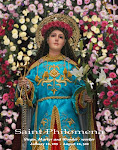An interesting article from the Philippine Daily Inquirer (Monday, January 31, 2011):
BAGUIO CITY—Never too old for “Toyang.”
Catholic nuns on Saturday night danced to this Eraserheads hit inside Baguio Cathedral as part of a vocational drive to recruit new blood.
“There is a dwindling [number] of [entrants] through the years. But
because of this, we might be able to get recruits,” Sr. Eva Vargas of the Villa Milagrosa Convent told the Inquirer.
About
30 nuns, aged between 25 and 80 years and who came from different Catholic congregations, danced at the altar before more than 100 churchgoers to the tune of “Toyang,” a hit among the youth in the 1990s.
The song, released in 1993 by the band Eraserheads, talked about a young man’s wish to be with a simple girl.
Joining the nuns was a group of actors who depicted how parents instill values among their children.
“The family is beset with problems. We think that discussion about vocation should start in the family,” Vargas said.
New members needed
She said they wanted to reach out to young women so the program would be brought to the city’s Catholic parishes and universities.
“We danced to ‘Toyang’ because the song is very popular among the youth. This will call their attention,” Vargas said.
The nuns also danced to “I Will Follow Him,” which became a household tune courtesy of the 1992 Whoopi Goldberg starrer “Sister Act,” to Abba’s “I Have a Dream,” and “Our Mission,” a composition by Fr. Carlo Magno Marcelo of the San Carlos Seminary here.
Vargas said 10 more performances were scheduled in Catholic churches and universities here until Feb. 7. The nuns will be joined by child performers and dancers as they tour the community.
Sr. Alice Lansang, chair of the Association of Women Religious (Baguio-Benguet), said local churches needed new staff members and missionaries.
“The city has 19 congregations of religious women, which have 95 members. [Most are] elderly and retired [nuns] … Schools, retreat houses and parishes are understaffed,” Lansang said.
Another calling
Vargas said through their campaign, the nuns also wanted to clear misconceptions toward their vocation.
“The sisters are not just there to pray in church. We can still be ourselves. Through dancing we can show the people that the life of sisters [is also fun],” she said.
She said women could choose to stay single and focus their lives on serving God and their community.
Vargas said many young people only thought about getting married.
“But there is also another kind of calling, which is the religious life, giving up
a part of themselves for God,” she said.
Follow the Link:
Nuns dance to get recruits in Baguio City - INQUIRER.net, Philippine News for FilipinosI find it strange that nuns should resort to dancing to the tune of a pop song in order to recruit new vocations. Even more strange is that they did it in front of the altar of the Cathedral. The objective for them was very simple: “The sisters are not just there to pray in church. We can still be ourselves. Through dancing we can show the people that the life of sisters [is also fun].”
The good sister seemed to give us the impression that when sisters pray in church, they are not themselves. It is sad that
even sisters think that praying in church is no longer attractive for the young. Thus, they danced in order to show people that the religious life is also fun.
First of all, young people are attracted to the religious vocation not because they think it is fun but because they think it is different. The religious life has something which other institutions cannot offer. Our error is really working on the impression that if the religious life is shown as no different from other professions, it would attract other young people. Dancing nuns and singing priests are shallow attempts to attract vocations to the religious life and to the priesthood. They do not appeal to the idealism of the young. Heroes and Saints make truly lasting impressions on the young.
It is when the young are shown the sacredness of the religious life that they are attracted to it. A return to the sense of the sacred is the real vocation promotion. Look at the statistics of traditional religious orders. They speak for themselves.
Religious life as giving
part of the themselves to God? I always thought it was
all or nothing!
Oh! "Toyang" is not an appropriate song for nuns to dance to (if they want to attract vocations): Read the lyrics and judge for yourself:
They try to tell us where too young
Too young to really be in love
Refrain:
Bahay namin maliit lamang
Pero pero pero malinis 'to pati sa kusina
Kumain man kami laging sama-sama
Pen-pen-pen de sarapen
De kutsilyo de almasen
Haw-haw-haw de karabaw
De karabaw de batuten
Pengeng singko pambilbi ng puto
Sa mga tindera ng bitsu-bitsu
Skyflakes,coke 500 pahingi ng kiss
Pambayad mo sa jeepney kulang pa ng diyes
Chorus:
Mahal ko si Toyang
'pagkat siya'y simple lamang
Kahit namumrublema
Basta't kami ay magkasama
Madalas man kaming walang pera
Makita lang ang kislap ng kanyang mga mata
Ako ay busog na
At nakatambay kami sa Tandang Sora
Ti ayat ti masya nga baro
Ken balasang nataina
Uray man uray man uray man
Haan unay nga nadonya
(repeat refrain chorus)
The nuns are not listening to the music they danced to!



























